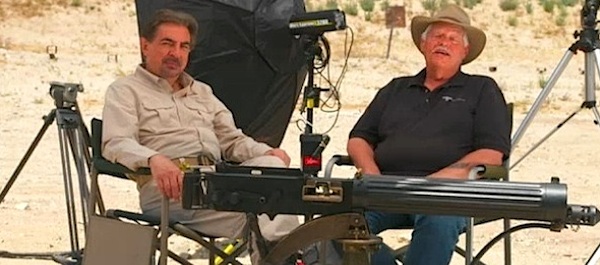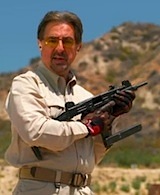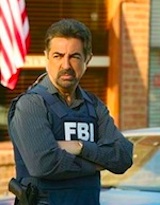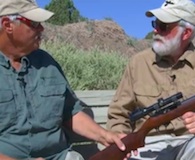
Joe Mantegna has one of the most diverse resumes in Hollywood. His acting career includes a Tony-winning performance as cynical real-estate agent Richard Roma in the play Glengarry Glen Ross. He’s appeared in over 100 feature films, including the role of Joey Zasa in The Godfather: Part III, roles in Woody Allen’s films Alice and Celebrity, and the character of Jerry in Things Change, for which he and co-star Don Ameche both received the Best Actor Award at the Venice Film Festival. On television, his starring role in The Last Don CBS miniseries earned an Emmy. He is perhaps most familiar to audiences as David Rossi, an FBI profiler on Criminal Minds, Police Chief Will Girardi on Joan of Arcadia, and as the voice of Springfield crime boss Fat Tony on the long-running animated series The Simpsons. He is also co-producer and narrator of MidwayUSA’s Gun Stories, an Outdoor Channel series that explores the history and technology of firearms, which begins its third series tonight, July 3, at 8 p.m. Eastern Time.
A strong supporter of America’s military personnel, he has co-hosted the National Memorial Day Concert with his friend, actor Gary Sinise, since 2006. He is also the national spokesperson for the campaign to build a National Army Museum.
He took some time from his busy schedule to talk with HistoryNet‘s editor, Gerald D. Swick, for an exclusive HistoryNet interview.
Gerald D. Swick: First of all, would you tell us a bit about Gun Stories and some of the stories we can expect to see on the show’s third season?
 Joe Mantegna: Each year we try to profile what we consider historic firearms. We open up with the Uzi this year. I think I end up shooting three different versions of the Uzi on that episode. We’re also doing the Vickers machine gun, a very historic weapon that is the classic water-cooled machine gun. For the Benelli shotguns, we went to the Benelli factory in Italy. And there’s the Winchester 1873, the only gun ever to have had a movie made about it (Winchester ’73, a 1950 Western directed by Anthony Mann and starring James Stewart and Shelley Winters). We’ll be showing the .450 Nitro elephant gun and the derringer. On the derringer episode, we shot everything from a .22 bullet to a .410 shotgun shell out of one those little guns.
Joe Mantegna: Each year we try to profile what we consider historic firearms. We open up with the Uzi this year. I think I end up shooting three different versions of the Uzi on that episode. We’re also doing the Vickers machine gun, a very historic weapon that is the classic water-cooled machine gun. For the Benelli shotguns, we went to the Benelli factory in Italy. And there’s the Winchester 1873, the only gun ever to have had a movie made about it (Winchester ’73, a 1950 Western directed by Anthony Mann and starring James Stewart and Shelley Winters). We’ll be showing the .450 Nitro elephant gun and the derringer. On the derringer episode, we shot everything from a .22 bullet to a .410 shotgun shell out of one those little guns.
We interview different people, besides showing and shooting the guns. It’s a show for those who care about historic firearms, and it has done well. We’re looking forward to starting season four.
GDS: How did you become involved with the show?
JM: It was one of those things where I got asked. The Outdoor Channel heard I’d dabbled in firearms, doing some trapshooting and some target shooting when I was younger. They sent me an email, and I followed up.
GDS: What gun do you personally find the most fascinating and why?
JM: That would depend on what category you’re talking about. Most of the shooting I do now is shotgun shooting, such as trap, sporting clay and skeet. I favor an over and under. I have a couple of Berettas.
In rifles, I like the Ruger Mini-14. I was just up at Benelli’s (a manufacturer of rifles and shotguns), and they have a new Argo rifle I like very much. I also like the Ruger 10/22; they make a new Takedown version that’s a nice little gun for target practice.
In pistols, I like the Colt Model 1911. The Cabot Gun Company makes a fantastic 1911, I have one already and they are making one form me to use on Criminal Minds. Wicked Grips is also making some pretty cool grips for it.
 GDS: On Criminal Minds, your character, David Rossi, carries a Colt Government Model 1911. We understand you personally chose that for his weapon. Why did you feel that was the best fit for Rossi?
GDS: On Criminal Minds, your character, David Rossi, carries a Colt Government Model 1911. We understand you personally chose that for his weapon. Why did you feel that was the best fit for Rossi?
JM: He’s a Vietnam vet. He’s been around for a while. He embraces things that he considers classic—collects fine art, likes an occasional cigar and brandy. He admires workmanship in everything, so the Colt 1911 would appeal to him. He probably feels safest and most comfortable with something he’s familiar with. I feel that way myself and probably infuse David Rossi with that same kind of sentiment.
GDS: There have been other television shows exploring guns; there are books like The Shooter’s Bible and organizations of firearm aficionados, Go into any museum where guns are part of the display, and you’ll almost always see people gazing at them. What do you think it is about firearms that creates such fascination with them?
 JM: First of all, they tell a history of civilization, in a way. Trace the history of firearms, and you are also tracing the history of almost every country on this planet. Every country has some firearm it manufactured or became the victim of. There’s an inherent danger in a firearms—that’s understood—but we also understand that as civilized humans we invented this thing. You have to respect it; it is the result of design, of technology, of craftsmanship. There is inherent drama as well: firearms are used for protection; they’ve been used for assassination. They run the gamut from ugly, homemade firearms used in coups to guns made by criminals who tried to create things to commit crimes with to firearms that are works of art and that cost hundreds of thousands of dollars. There’s really not anything else you can say that about.
JM: First of all, they tell a history of civilization, in a way. Trace the history of firearms, and you are also tracing the history of almost every country on this planet. Every country has some firearm it manufactured or became the victim of. There’s an inherent danger in a firearms—that’s understood—but we also understand that as civilized humans we invented this thing. You have to respect it; it is the result of design, of technology, of craftsmanship. There is inherent drama as well: firearms are used for protection; they’ve been used for assassination. They run the gamut from ugly, homemade firearms used in coups to guns made by criminals who tried to create things to commit crimes with to firearms that are works of art and that cost hundreds of thousands of dollars. There’s really not anything else you can say that about.
GDS: You’re the national spokesperson with the project to build a National Army Museum. Many Americans would probably be surprised to learn there isn’t such a museum already. How did you get involved?
JM: Right. Part of it came from my involvement with the National Memorial Day Concert. I was approached by General Creighton Abrams, son of the famous World War II General Abrams they named the tank after. He was representing the group of retired Army officers who are spearheading the drive to make this museum a reality, and he asked if I would be spokesman. I was incredibly flattered to be asked. I consider it an honor.
GDS: You’ve voiced the Springfield crime boss Fat Tony on The Simpsons for 23 years now, and you have said that despite your hectic schedule, “Nothing interferes with my doing The Simpsons!” What is it you enjoy so much about that role?
 JM: Well, first of all, it’s my longest-running character. Seven seasons on Criminal Minds doesn’t even come close. I hope to continue doing Fat Tony. Besides, I’m a firm believer that if I’m going to do something, I’m going to do it all the way. If I’m called on to do something dangerous, I’m not going to put a stunt person out of work by trying to do it myself, but if it’s just a case of showing someone else’s hand on the screen and pretending its mine or having someone else who sounds like me say a line because I’m not available—I’d rather do it myself. The audience will never know, but I’ll know it wasn’t me, and that’s enough. If it’s got my name on it, I want to make sure it is done right.
JM: Well, first of all, it’s my longest-running character. Seven seasons on Criminal Minds doesn’t even come close. I hope to continue doing Fat Tony. Besides, I’m a firm believer that if I’m going to do something, I’m going to do it all the way. If I’m called on to do something dangerous, I’m not going to put a stunt person out of work by trying to do it myself, but if it’s just a case of showing someone else’s hand on the screen and pretending its mine or having someone else who sounds like me say a line because I’m not available—I’d rather do it myself. The audience will never know, but I’ll know it wasn’t me, and that’s enough. If it’s got my name on it, I want to make sure it is done right.
GDS: You’re co-producing and narrating a documentary about the late writer Ray Bradbury. That’s due out later this year, isn’t it?
JM: I think we’re going to do an advance publicity event at Comic-Con. Ray was a dear friend for many years. I think this documentary will be a great opportunity for people who were interested in Ray Bradbury to get a snapshot of his life and his career. He was a wonderful human being.
GDS: I’m one of those people. He was one of my favorite writers and a big influence on my own writing. How did the two of you meet?
JM: I met him in 1973. I was doing a play in Chicago, The Wonderful Ice Cream Suit, based on stories he’d written. He came to Chicago, saw the play and loved the production. We toured Europe with it, and later made a movie of it. Up to day he died, he said that movie was his favorite of all the films that had been made from his stories, that it was the closest to his original script. It’s a wonderful movie, a great family movie, something you can watch with your children, with your grandparents I know Ray loved the movie and I loved making it. (The film is available on DVD).
GDS: Thank you for your time. Best of luck with the new season of Gun Stories.
Visit Joe Mantegna’s website to learn more about his multifaceted career.
[nggallery id=144]




